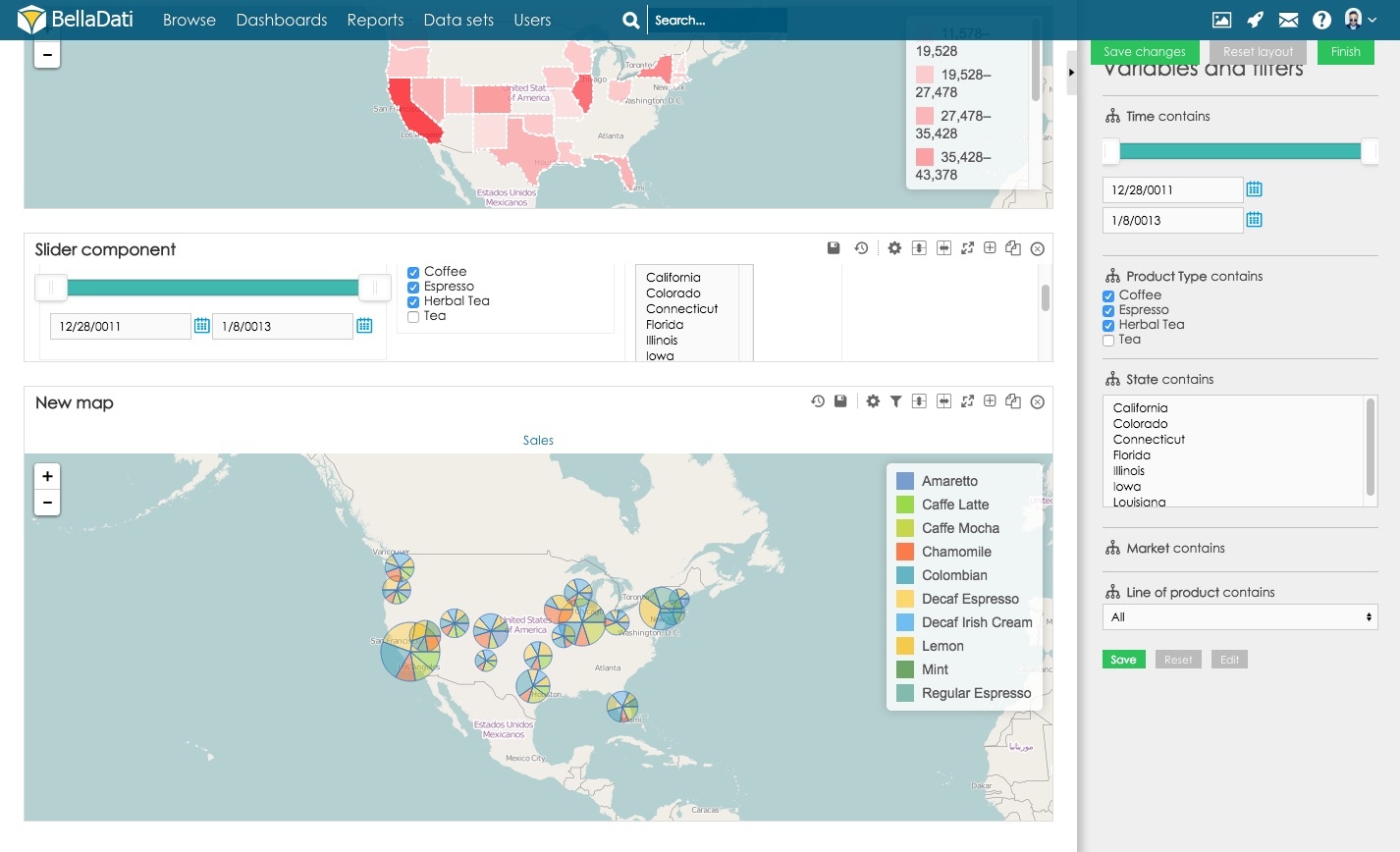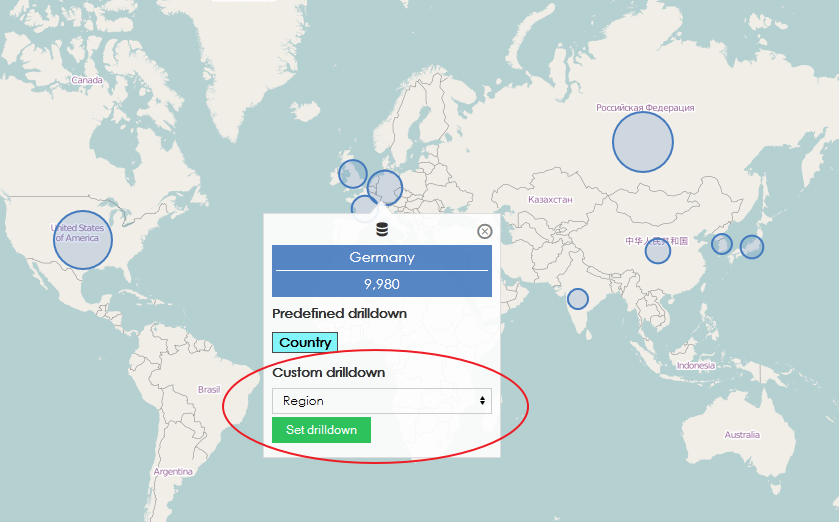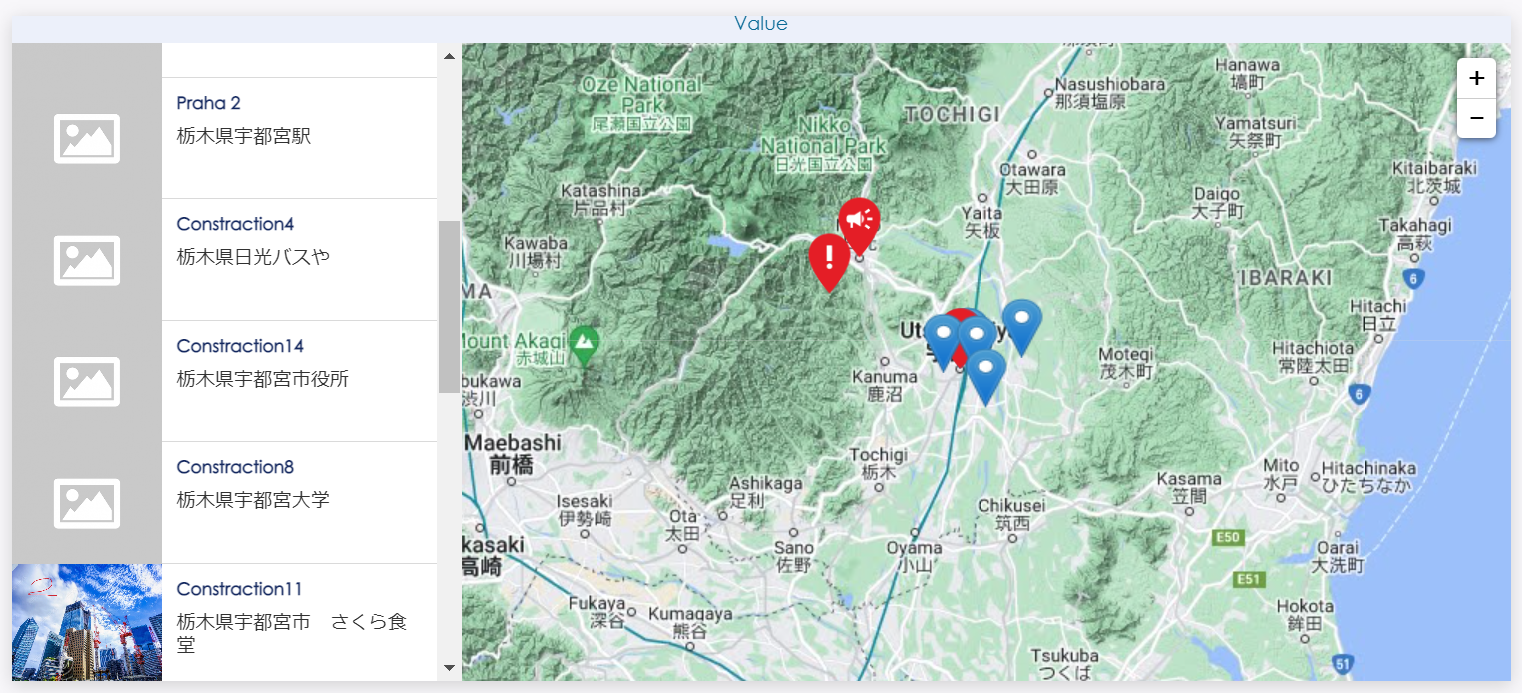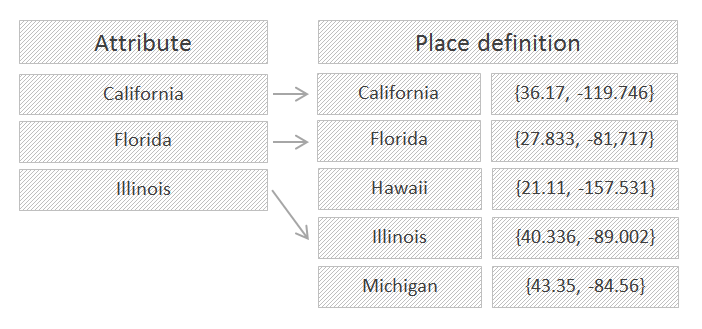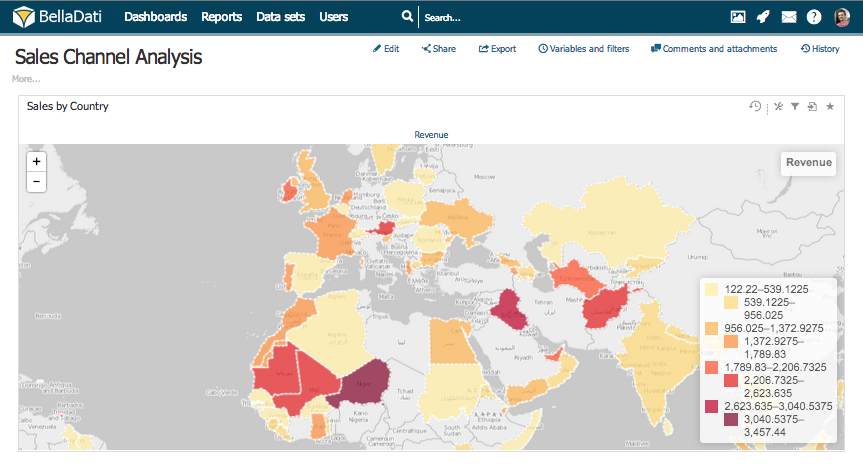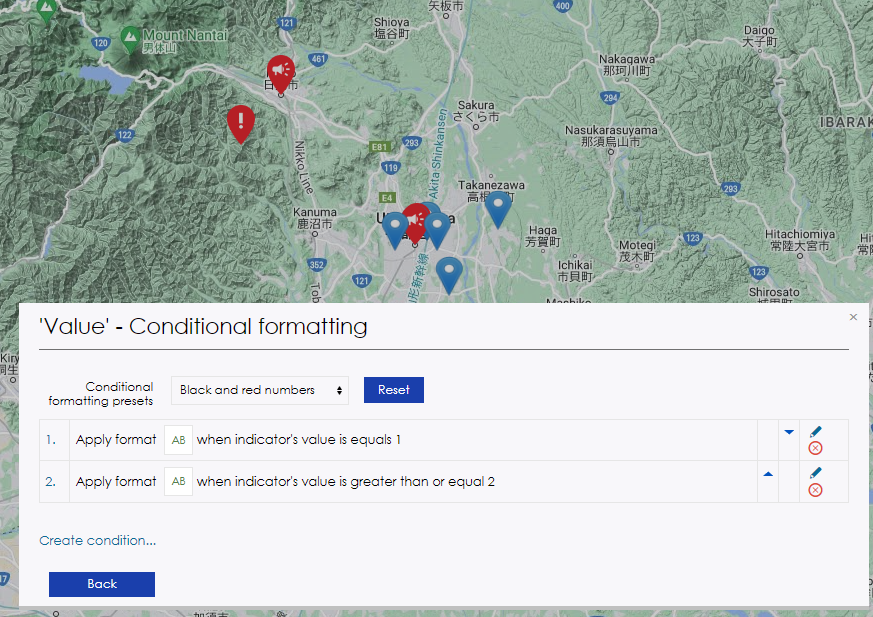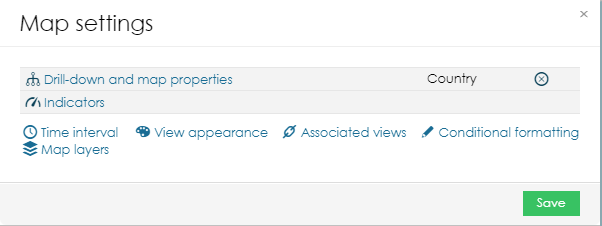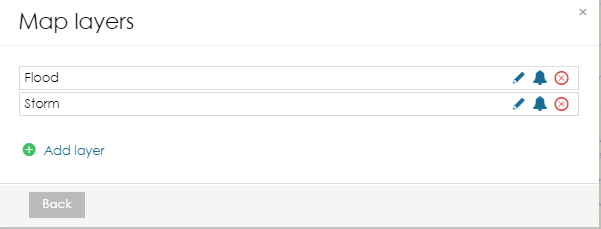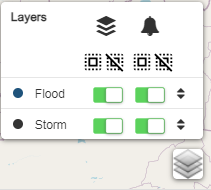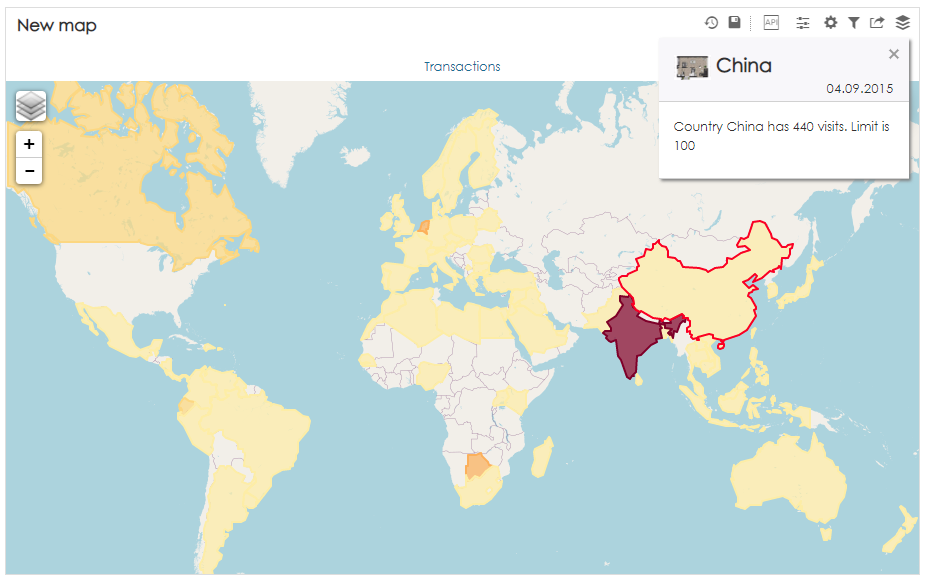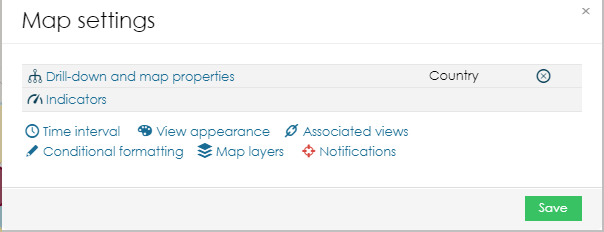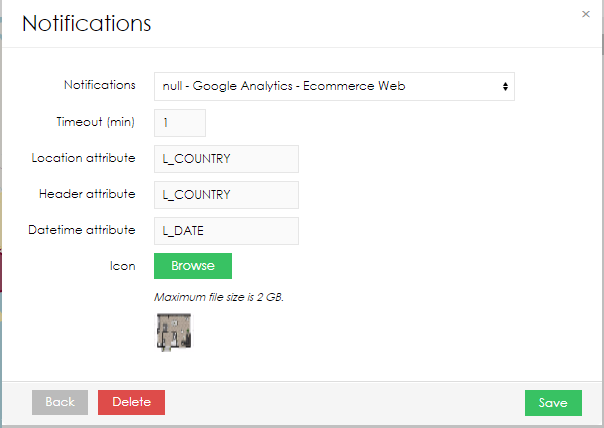Geo maps allow you to visualize Indicators on the interactive maps.
You need to be in edit mode in order to create new Geo map. Click on "Edit" in top report menu to activate edit mode.
Map Charts Geo Data needs to be defined prior to creating new Maps. Or the Data Set has to include GEO Point attribute or GeoJSON attribute.
To add a new Geo map, hover over Insert new row and click on Map view type. New Map dialog will appear.
- Enter the name of the New map and select Indicators that should be displayed in the map
- You have to add Drill down to complete the view setup. Drill down defines which attribute will be used to categorise and position data on the map (for instance Sales indicator for specific State)
- You can select Show details for. This option will do drill-down for selected Indicator according the attributes (for instance Sales Indicator for specific State and specific Coffee Product)
- You can enable "Show values" to display indicator values on map.
Example: The most common drill downs associated with Geo maps include Country, Region or City. When Country attribute is selected:
- Indicators are grouped according particular country.
- Values are placed to proper position corresponding with country location.
Drill Down
You can specify drill down from Chart settings. To access dialog:
- click on add drill down to complete the view setup link in the created view.
- enter Map chart settings dialog from the toolbox and click Add drill down path.
Custom drill down
As in chart and tables, you can set another drill down to change the granularity of map. To do so you have to specify default GEO location mapper in Attribute settings in Data Set.
If it is all set, you can click on any drill down member, select Custom drill down Attribute and click on Set drill down.
If Predefined drilldown (for example Country > City) is also set, it is possible to drill-down with left mouse click. Default pop-up window is then available with right click.
You can download video of setting custom drill down here
Map settings
Map settings dialog allows you to:
- Specify Attribute or GEO Point to be used for aggregating and categorizing indicator's values.
- Show details for monitored Indicator
- Select Place definition for proper positioning and visualization of data.
- Manage places definitions - continue by Managing GEO Data .
- Select desired map provider.
- Setup Limit for members in the drill down path. Displayed memebers depend on current sorting setup.
- Specify Number of colors for shape-based map. By default, BellaDati will create scale with eight colors. Users can override this setting.
- Show administrative boundaries
- Show values
- Show attribute value list. Allow you to display the additional information and the image related to the displayed member.
- Using Member list settings you can define image and action on click to your attribute using formula and display additional description bellow Drilldown member. This only works for points in map.
- Value title - Select from what column should title be obtained
- Value description - Select from what column should description be obtained
If you enable Show attribute value image, Image formula field appears. There you can using formula define your image from media gallery. See example
return '/bi/media:showimage/'+imageId;
If Image formula will return an array, slideshow will be used on mouse hover every 2 seconds. See example
return ['/bi/media:showimage/36','/bi/media:showimage/11','/bi/media:showimage/5','/bi/media:showimage/41']
If you enable Show actions formula, Actions formula field will appears. It must return a map with icon and link. See example
return [[icon:'edit',link:'report:89?ID='+id]]
- Display Marker instead of points.
- Link values on the map with a line. Define the weight and color of the line. Or hide points on the line, which links the locations.
- PINs link - you can define an action to open a popup window with a specific report.
- Variable can be passed like this: viewreport:287-Ty9CWFdvmo?parameter1=@parameter1
- Drilldown value can be passed like this: viewreport:287-Ty9CWFdvmo?parameter2=$attribute
- Layers opacity (%) - Takes values from 1-100 to set opacity of layer fill. Border of layer will stay not changed.
Associating Attribute with Place definition
There is a fragile connection between drill down and place definition. While drill down maintains indicator values and their categorization, place definition keeps pairs of location identification and its coordinates. BellaDati automatically connects attribute's members with places and therefore enables their proper positioning.
You should always select only attributes which can be associated with an existing Place definition. In case of an attribute with no related Geo data, indicators will not be displayed appropriately.
Drill down option allows you to define:
- how displayed indicators will be grouped and categorized.
- what granularity will visualized data have.
- which mapping background will be used (Standard, Black & White, Gray Scale, Outdoors, Cyclo, etc.)
Place definition option is used to associate selected attribute with Geo data.
Select Place definition according to:
- Drill down path you selected.
- Style of visualization you want to apply (point vs. region).
Each Place definition includes pair on place identification and its coordinates.
Coordinates can be represented as:
- Points. In point definition, location is identified by pair of values representing exact longitude and latitute.
- Regions. In region definition, area is restricted with polygon, composed of set of longitude and latitude values.
For more information about Place definition continue by Managing GEO Data .
Using GEO Points
GEO point is a special attribute type holding latitude and longitude coordinates of a special location. GEO points are most convenient to use when location information are stored directly in imported Data Set. It automatically generated its own place definition and can be directly used in reports.
To use geo points:
- Select GEO point attribute in Drill-down settings
- Find relevant Point definition
- Choose desired map provider
Map management
You can perform additional operations in upper right corner of the inserted Map view:
- Table settings
- Filter setting - continue by Static Filters.
- Export view - continue by Exporting View
- Add to dashboard
- Move map
- Duplicate map
- Delete map
Map settings
Click on toolbox icon to enter Map settings dialog.
Map settings dialog shows Indicators and Drill down path currently applied to the map. BellaDati allows you to:
- Enter indicators or drill down path dialogs.
- Remove drill down path.
- Add time axis - continue by Setting Date Interval .
- Add conditional formatting - see next paragraph.
Conditional formatting
There are two types of conditional formatting available for maps.
- Conditional formatting for indicators - Displaying Indicators.
- Background color applies to shapes and foreground color for points.
- The displayed pin icon can be changed depending on the condition
- Map conditional formatting - chosen color is applied to drill-down member whose value is smaller or equal than specified value. You can create your own color scheme by using multiple rules.
Displaying image in indicator details
If there is added image to the attribute member which is used in the map, this image will be also displayed in indicator details.
Images can be managed in attribute members appearance.
Map layers
Allows you to set a set of new layer on top of all layers. Those layers can be turned on and off by button, color can be defined, and indicator value is defined by formula. It has similar settings as shape maps. For each layer specific notification can be assigned. Using drag and drop, possition of layer can be changed.
In Map settings select Map layers
Map layer settings
- Name - name of this specific layer
- Basic color - this color will be used as a color of your layer.
- Drill down by - here you specify your attribute to be used as drill down.
- Places definition - Select Place definition for proper positioning and visualization of data. For more information about Place definition continue by Managing GEO Data .
- - Instead of selecting value for Places definition from column, you can define those definition using a formula. Formula must return one value, or array of values.
- Icon - select icon, that will be used in right bottom corner to enable or disable this layer
- Formula - Instead of setting your indicator, define your value using formula
- Enable mouseover - This will enable additional formula, that will override "Formula" and its visual. Only label will be displayed with returned value of formula
- Enable label - This will enable additional formula, that will place text defined in formula over a place definition inside of map.
Canvas layer - This is special feature, that allows you to draw your special information inside of map
//code example var context = canvas.getContext('2d') context.beginPath(); context.arc(100, 75, 50, 0, 2 * Math.PI); context.stroke();
Notification settings
- Notifications - List of all System notification that will trigger associated layer
- Timeout - Validity of notification
- Location attribute - If location is sent as part of notification and this attribute value is stored in source notification dataset, then it will be paired with place definition. If those conditions are met, place will be highlighted when hover over notification label with cursor. In this case, you will set attribute name of locations stored in source dataset, that handles notification.
- Group by location attribute - Notifications can be grouped by the location attribute. In that case, notifications are compared whether they match except the location value and then show as one with locations as list highlighting all locations.
Available locations attribute/formula - You can specify, what places can be shown as notification. You can select attribute from dataset, or define using formula
return ['Germany','Czech Republic']
- Header attribute - Set name of attribute from notification dataset, that will define header of notification
- Datetime attribute - Set name of attribute from notification dataset, that will place datetime and sort notifications accordingly.
- Icon - It will place informative icon for specific notification.
Notifications
Allows you to display lists of multiple notifications according to set rule in Data set Notification. After mouse hover over notification, area can be highlighted.
- Create your notification definition in Notifications. As notification action use "System notification"
- In Map settings select Notifications
- In Notifications select, you should be able to see and pick your System notification
- Timeout indicates after what time closed notification will no longer appear, when page is loaded again.
- Location attribute allows you to highlight area of specific notification on the map. In this case, every notification will highlight country of origin.
- Header attribute shows title of each notification.
- Datetime attribute if sets, display date and time. This is not time of notification sent, but time from dataset.
- Icon, each notification can have the same icon next to the text
Linking points on the map
If you want to link the points in the map, select the option link values. In this case, the values are linked based on drill-down used in the map. The drill-down should contain the sequence of the points, e.g. timestamp of the visualized trip.
If you want to highlight the points on the map, select one of the markers (option display marker):
Video Tutorial
Next Steps | Related content |
|---|---|
${xhtml} |



